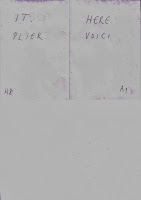- Take a Latin text (or a text in whichever language you translate from, with your rights to it or with copyrights already expired, if I can add some juridical advice), insert it into a table and insert before it starts the first tr = table row which is marked valign="top" = vertical alignment so that tops are on same level, and the first td = table detail:
<table><tr valign="top"><td>Deinde cum dicit ....
...</table>
- Divide it into sentences through insertions of following "balises" (tags, I nearly forgot translating the word):
Non quod philosophi, ductu rationis, potuerint pervenire, per ea quae facta sunt, in cognitionem personarum quantum ad propria, quae non significant habitudinem causae ad creaturas, sed secundum appropriata. <td> & nbsp ; <td>
<tr><td> & nbsp ;
<tr valign="top"><td>Dicuntur tamen defecisse in tertio signo, id est in spiritu sancto quia non posuerunt aliquid respondere spiritui sancto, sicut posuerunt aliquid respondere patri, scilicet ipsum primum principium, et aliquid respondere filio, scilicet primam mentem creatam, quam vocabant paternum intellectum ut Macrobius dicit in libro super somnium Scipionis
- Add your translations on the right hand side of the upper part of each such divide:
Uno quidem modo per causalitatem. <td> & nbsp ; <td>One way is by causality.
<tr><td> & nbsp ;
<tr valign="top"><td>Quia enim huiusmodi creaturae sunt defectibiles et mutabiles, necesse est eas reducere ad aliquod principium immobile et perfectum. <td> & nbsp ; <td>For because suchlike creatures are defective and mutable, it is necessary to reduce them to something immobile and perfect.
<tr><td> & nbsp ;
<tr valign="top"><td>Et secundum hoc cognoscitur de Deo an est. <td> & nbsp ; <td>And according to this it if known of God "whether" [=that!] He is.
<tr><td> & nbsp ;
<tr valign="top"><td>Secundo per viam excellentiae. <td> & nbsp ; <td>Next by the way of excellence.
- How does this look when finished?
Here is a preview from first paragraphs of the passage:
Deinde cum dicit quia quod notum est, manifestat propositum, ordine tamen retrogrado. Next, when saying "that which is known", he manifests the meaning, but in reverse order. Primo enim consentit quod sapientes gentilium de Deo cognoverunt veritatem; secundo, ostendit quod in eis impietas et iniustitia fuerit, ibi ita ut sint inexcusabiles; tertio quod iram Dei incurrerunt, ibi qui cum iustitiam Dei. For first he agrees that the wise of the geintiles knew the truth about God; next he shows that there was impiety and injustice in them, in that place "so that they were inexcusable"; thirdly that they incurred the wrath of God in that place "who, having [known] the justice of God" [verse 32 - verses were not yet made for the Bible.] Circa primum tria facit. About the first thing he does three things. Primo, quid de Deo cognoverunt; secundo, ostendit a quo huiusmodi cognitionem acceperunt, ibi Deus enim illis; tertio, ostendit per quem modum, ibi invisibilia enim. First what they knew of God; then, he shows from whom they received suchlike knowledge, in that place "For God hath manifested it to them" (v. 19); thirdly, he shows in what manner, in that place "For the invisible things of him" (v. 20). Dicit ergo primo: recte dico quod veritatem Dei detinuerunt, fuit enim in eis, quantum ad aliquid, vera Dei cognitio, quia quod notum est Dei, id est quod cognoscibile est de Deo ab homine per rationem, manifestum est in illis, id est manifestum est eis ex eo quod in illis est, id est ex lumine intrinseco. Thus he first states: I am right to say that they have detained the truth of God, for there was in them, in respect to something, a true knowledge of God in them, "Because that which is known of God" (v. 19), that is what is knowable about God by man by reason, "is manifest in them" (v. 19), that is it is manifest to them from what is in them, that is from their interior light.
This will be made available in more detail and in context on my blog Creation vs. Evolution when writing about Roman 1:20 and Richard Dawkins. The Latin text is from:
Corpus Thomisticum
Commentaria in Romanus caput 1, lectio 6
http://www.corpusthomisticum.org/cro016.html
- How and why you do such a translation?
The how is about knowing the language. In this case Medieval Latin.
The why is about finding for instance St Thomas Aquinas' commentary to the Epistle to the Romans (here is from his lectio 6 to chapter 1) online in Medieval Latin and not having a clue where or if at all one English translation thereof is available even in print.
And of course finding something which an author not in Modern English online has said more appropriately than the authors that are available in that format. But once you start looking at St Thomas Aquinas (or some other author from the ages of faith which were also the true ages of reason), and comparing what he has to say to what is available that is not a problem.
Hans-Georg Lundahl
Nanterre UL
St John Bosco
Founder of Salesians
and of Institute of Daughters
of Mary Help of Christians
31-I-2014
Update, St Matthias Day, here are the tables or rather the posts that include them:
Creation vs. Evolution : Romans 1:20 and Dawkins, Richard
http://creavsevolu.blogspot.com/2014/02/romans-120-and-dawkins-richard.html
Origen also made a Commentary on Romans, including of course 1:19 and 1:20
http://creavsevolu.blogspot.com/2014/02/origen-also-made-commentary-on-romans.html




